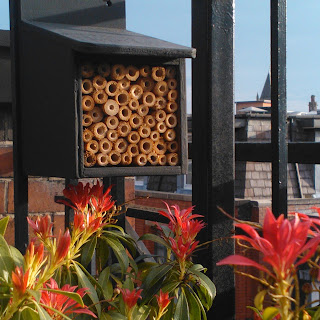The season
turns to spring and Nature's rejuvenation begins all over again. Looking out at
the surrounding buildings I see windows, long closed against the weather, now flip
open and neighbours' faces, not seen for months, jut out to breathe in the mild
air. I discern in myself a lifting of the spirits, an accompanying surge of
optimism - and a motivation to take positive action. I rummage in the utility
room for the nesting hut for solitary bees which I had thoughtfully refurbished
before storing it over winter. I hang it on the balcony rail (facing South-West
as advised by the instruction leaflet) in anticipation of an eager tenant. I go
inside to put away some winter clothes and come across my favourite but
dilapidated brown leather boots. I have an idea to get them fixed so that they
will be ready for next winter.
Within the
hour I set off to the repair shop, motivated not only by the sunshine but also
by the need to distract myself from constantly checking the bee-hut. There are
three repair shops to choose from. At the first one the man inspected the
boots, looked at me sardonically and said "Let me put it this way: how
much do you love them?” He then quoted an extortionate price. At the second shop the man quoted a similar
price - but without the nicety of foreplay. I gave the third one a miss and opted
instead to take my boots to a coffee house where I could ponder the following
dilemma: should I get them repaired at all - or should I just throw them away
and buy new ones? In my business days I would have resolved it with a straightforward
cost/benefit analysis but now it has become a lot more complicated.
Years ago,
when most of our things were made in Britain, mending them would have been a
foregone conclusion. Nowadays our things are made elsewhere and more cheaply, by
exploited labour in overseas factories we would rather not know about. Not only
does the cost of repairing them in the West exceed the cost of making them in
the East but also, for me at least, an ethical aspect has arisen. Should I get
them repaired, thereby supporting the local workers' wage or should I buy a new
pair, thereby contributing to the wages of poorer, foreign workers?
On top of
this are the ecological considerations: if we were all to consume fewer
manufactured goods the world's natural resources would be under less pressure; if
we continue to transport these goods over long distances we risk global warming;
and, if we buy ever more goods from emerging economies, we encourage them to over-industrialise
instead of developing as sustainable economies.
In terms
of shoes, we could address these concerns by buying fewer but better quality,
longer lasting pairs, sacrificing fashion at the altar of practicality. We
could even foster a return to the golden era of manufacturing when all shoes
were made in Northampton - from best quality leather and to just a few
established designs - tan brogue for country wear, black leather for city wear,
glossy patent for formal wear. I recall that such shoes lasted for years and,
if bought late in life, could be bequeathed in one's will to grateful offspring.
Buy cheap, buy twice was the motto back then.
My mood of
optimism had drained away by the time I was down to the dregs of my coffee, and
I opted instead to postpone a decision until autumn. Who needs boots in spring
anyway? So I mooched home via shoe shops, half-heartedly looking in windows for
replacements for my old favourites. None could compare. After a while, however,
I began to notice the new season's displays of natty, canvas pumps. Ideal for
the coming summer, I thought.

Bee nesting huts - who knew?!
ReplyDelete